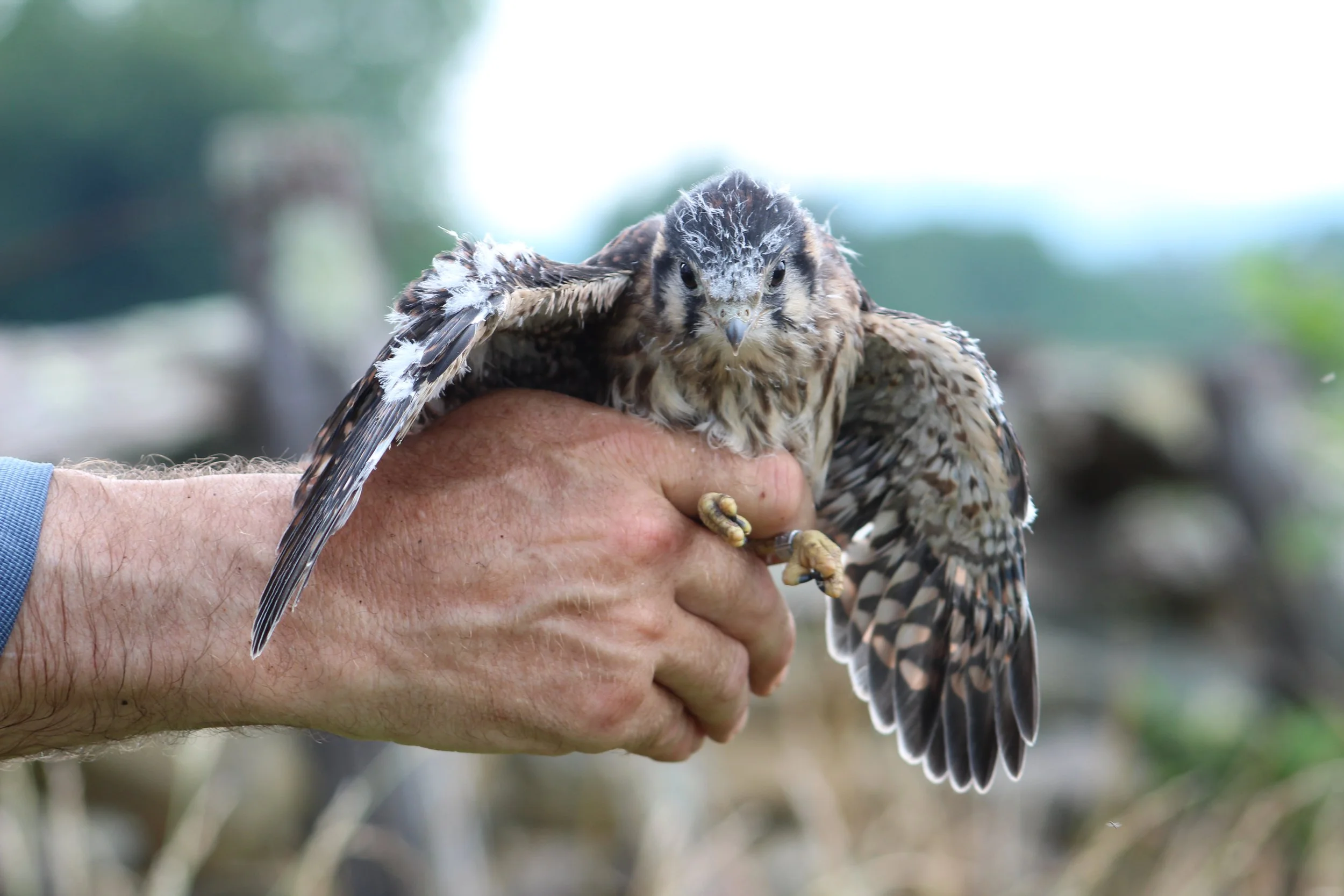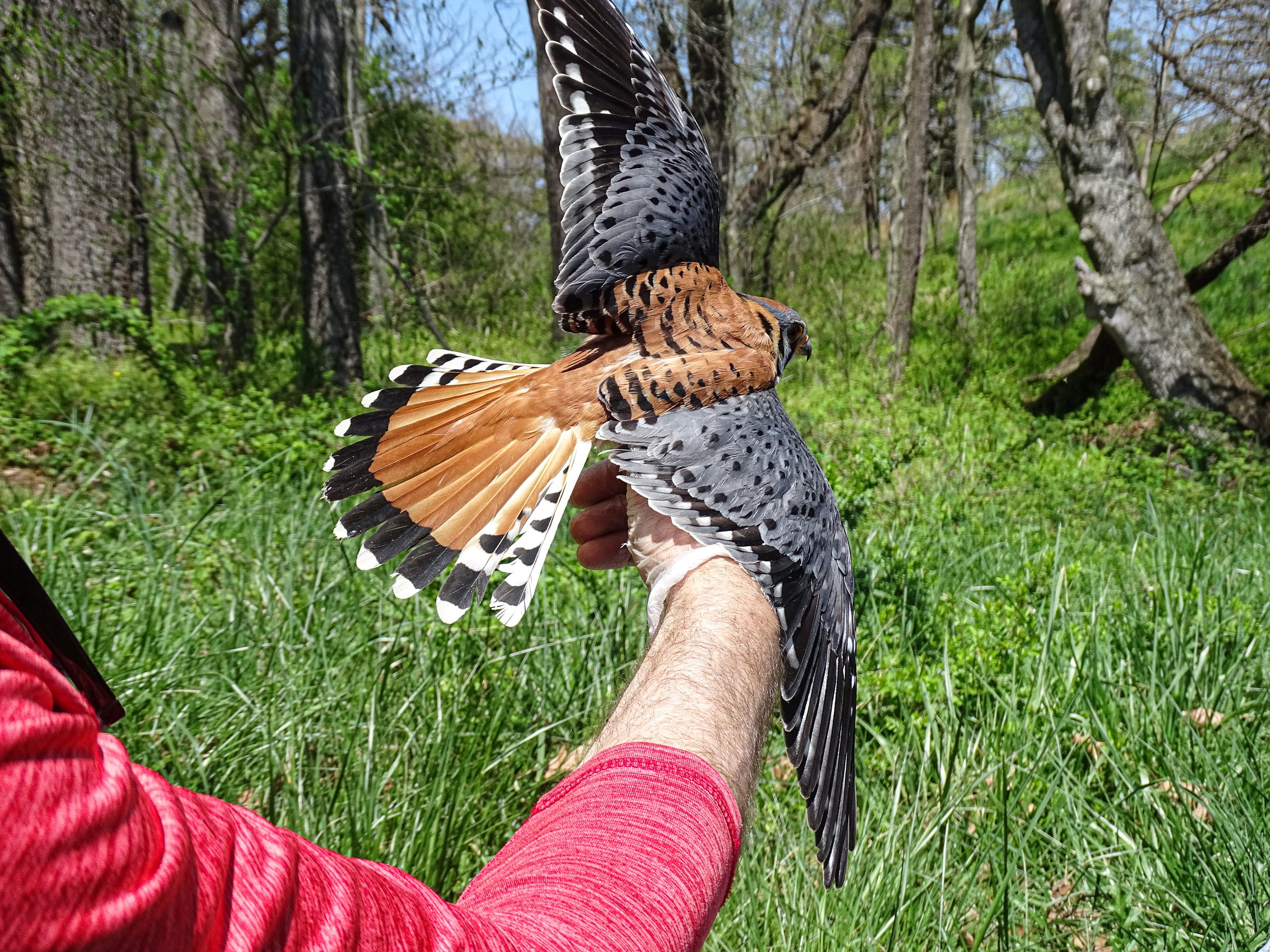Saving America’s Littlest Falcon
Emily Ellis
Only slightly larger than a songbird and fiercer than raptors three times their size, American Kestrels are a fixture of many rural landscapes. They can often be spotted hovering over brushy fields like small drones with their eyes fixed on a vole in the grass, or perched on fences and telephone wires with their unique rust-and-blue plumage glinting in the sun.
They have also lost half their population over the past 50 years, for reasons that aren’t fully understood by researchers. In the meadows and expansive farmland of Northern Virginia, many environmental organizations – including the Oak Spring Garden Foundation – are banding together to learn more about the country’s smallest raptor.
“It's really important to try to understand why the species is declining, and then how we can help bring back that population to a sustainable level,” said Joshua Rector, Oak Spring’s Wildlife Conservation and Management Specialist.
Bird bander Alan Williams holds an adult kestrel at the Oak Spring Garden Foundation. Photo by Joshua Rector.
Since late 2021, Joshua has been leading Oak Spring’s kestrel monitoring program, which involves putting up nesting boxes, banding nestlings and adults, and sharing data and observations with other organizations in the area. Although the program at Oak Spring is in its early stages, Joshua has been pleased with its success so far: out of 17 nest boxes installed throughout the property with the guidance of local grassland bird researchers, 15 were occupied. Out of 41 nestlings hatched at the time of writing this blogpost, 36 have fledged.
“I did not expect such high success,” said Joshua. “I was expecting maybe a few boxes to be occupied and rear eggs, and almost all of them have. So it's been really encouraging.”
The favorable environment at Oak Spring – with its restored grasslands, reforested woodland areas and number of wildlife snags – is likely one reason why kestrels were eager to make use of the nest boxes. A major factor driving their steep decline is loss of habitat, according to many researchers. As cavity nesters, the birds require old, gnarled and dead trees to raise their chicks, and there is fierce competition for those coveted spaces from other wildlife, including invasive species such as the European Starling.
A kestrel at Oak Spring hunts from a snag. Photo by Michael Carr.
Kestrels also prefer to hunt for voles, other small rodents and insects in scruffy meadows and livestock pastures, areas that are swiftly disappearing due to urban development and “cleaning up” of agriculture: landscape management that eliminates important wildlife habitat such as hedgerows, dead trees and long grass.
“Habitat change is probably the number one theory [for their decline], but then there are others as well,” said Bert Harris, executive director of the Clifton Institute in Warrenton. The Clifton Institute helped OSGF become involved in kestrel monitoring last year.
While loss of habitat is definitely a major reason for the kestrels’ decline, other troubling trends – including the shrinking size of adults, and poor juvenile and nestling survival – indicate that other factors are at play, Bert continued. Theories include predation from Cooper’s hawks, lack of food sources, and environmental contaminants, but more data is needed in order to pinpoint exact causes. Currently, the Clifton Institute estimates that American Kestrel nests in Virginia have an 80% survival rate.
“We’ve found a couple boxes with older, dead babies, just a few days before they’ve fledged,” he said. “We wonder what’s going on there, we have no idea.”
“So this year, we’re putting radio tags on nestlings so that we can follow them around and see how they do after they fledge,” he continued, adding that Clifton was also partnering with other groups to assess young kestrel survival in other areas. “We're also taking blood samples to look for contaminants.”
A mother kestrel with her newly hatched chicks in an Oak Spring nest box.
Being able to track and identify individual birds is essential for such research. Local conservationists have also been banding kestrels – a lower-tech process in which a metal “bracelet” with a number is affixed to a bird’s leg – for years. Although wild birds aren’t crazy about being handled, the quick, painless process is an essential way to help researchers to understand everything from their dispersal and migration, to their population and social habits, to preferred habitat, to their health and lifespan.
A female kestrel at Oak Spring is fitted with a transmitter from the Clifton Institute, which will help track her winter migration, habitat use, and other important information. Photo by Macey Wissell.
That is where licensed bander Alan Williams comes in. A biologist by training, Alan first became involved with kestrel monitoring over a decade ago when he began assisting kestrel advocate Roger Williams with installing nest boxes in the Fairfax area. Since then, Alan estimates he has helped install hundreds of boxes and band many birds in the region as more organizations and landowners become involved in monitoring kestrels. Plenty of interesting insights have resulted from those efforts, including several regarding kestrel migration patterns.
“One of the things that had been an unknown about this area is how much do kestrels migrate or where do they migrate and so forth,” Alan said. “And so the question is, are these birds that are here in the winter the same birds that are here in the summer?”
From recapturing banded birds in different seasons and tracking them with transmitters, local researchers have observed that some birds migrate to warmer states farther south, some come in from other states to overwinter in Virginia, and some stay year round.
“Some birds definitely do stick around for the winter,” said Alan. “Which is pretty cool.”
Joshua Rector removes kestrel chicks for banding from a nest box at Oak Spring. Photo by Macey Wissell.
When it comes to protecting kestrels, every little bit of data – from what nesting boxes the kestrels prefer to use, to what food they’re spotted bringing their young – is important for their conservation, and much of that can also be gleaned from simply observing the birds in their nests. That task falls to Joshua at Oak Spring, who spends at least one day per week going around to check each of the foundation’s nest boxes with a camera.
“There's a lot to find out [about kestrels],” he said. “One of the cool things that we've documented here was that we had a female change her box preference in the middle of laying eggs. We have the two boxes in the reforestation area, and she started laying in one box, two eggs, and then changed her preference and laid three more in another box. We don't know why she did that, or why she would do that. And then, because of incubation, those three are successful, but the other two are not.”
Northern Virginia’s Kestrels “continue to surprise us every year,” said October Greenfield, Wildlife Habitat Restoration Coordinator at the Piedmont Environmental Council and a bird bander who works with Alan Williams.
Bird bander October Greenfield holds a kestrel chick at Oak Spring. Photo by Macey Wissell.
“Just when we think we have it figured out, we'll put up a box location that looks like perfect habitat, and for some reason, they choose a box that we would consider to be a more general habitat for them,” she continued. “So we're still kind of understanding why they choose the locations they do and what kind of habitat they prefer to forage in at different times of year.”
Such discoveries wouldn’t be possible without the teamwork of so many organizations throughout the region. As local researchers continue to gather and compile data about the birds, increasing public involvement is an important next step for kestrel conservation, October continued.
“Anyone who has appropriate habitat around their land can put up a nest box and they kind of get to build this personal connection with their kestrels,” she said. “Kestrels are a great tool for getting more people involved in conservation in general, because we can put up the boxes and kind of invite them into our own backyards and get to observe their lifecycle, which is really special.”
Interested in getting involved with local kestrel conservation? Visit the Piedmont Grassland Bird Initiative website to learn about the organizations - including the PEC, Virginia Working Landscapes, American Farmland Trust and Quail Forever - that are fighting for kestrels and other grassland birds in Northern Virginia, and to find out about initiatives and resources for landowners who are looking to protect native wildlife on their property. You can also follow the Oak Spring Garden Foundation on Facebook, Instagram and Twitter to keep up with our wildlife conservation projects and learn about new opportunities to explore to explore and learn on the landscape.





